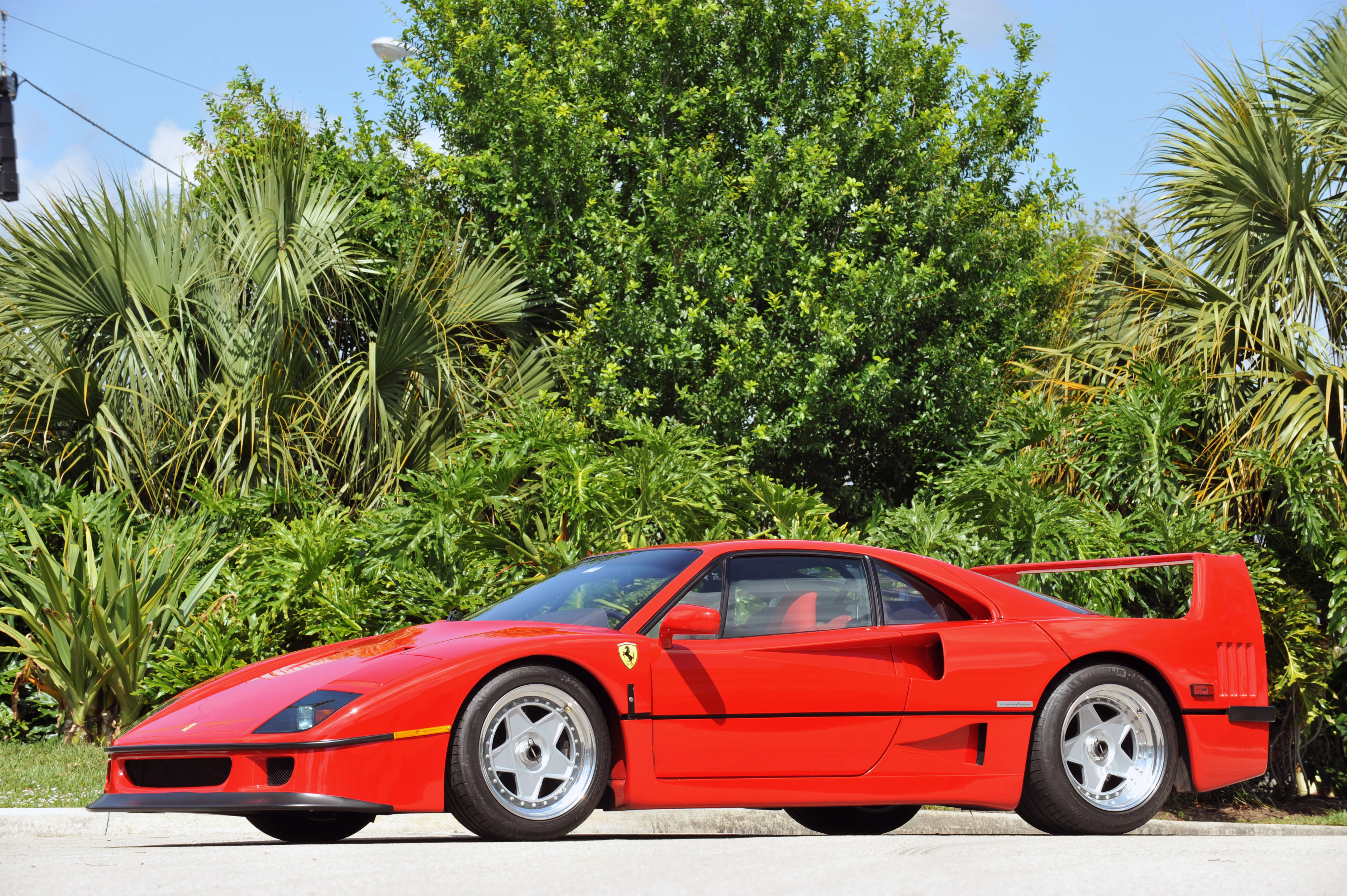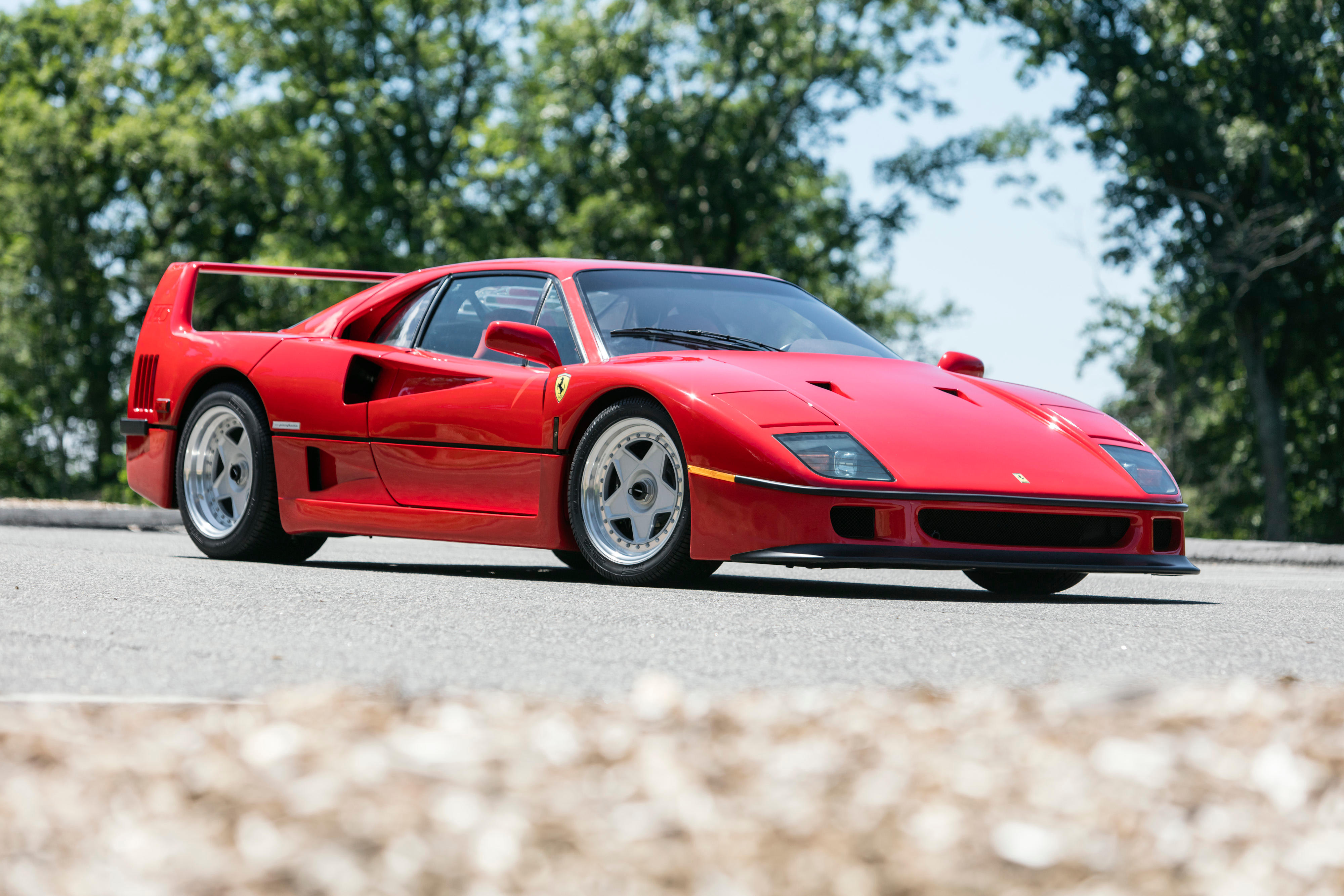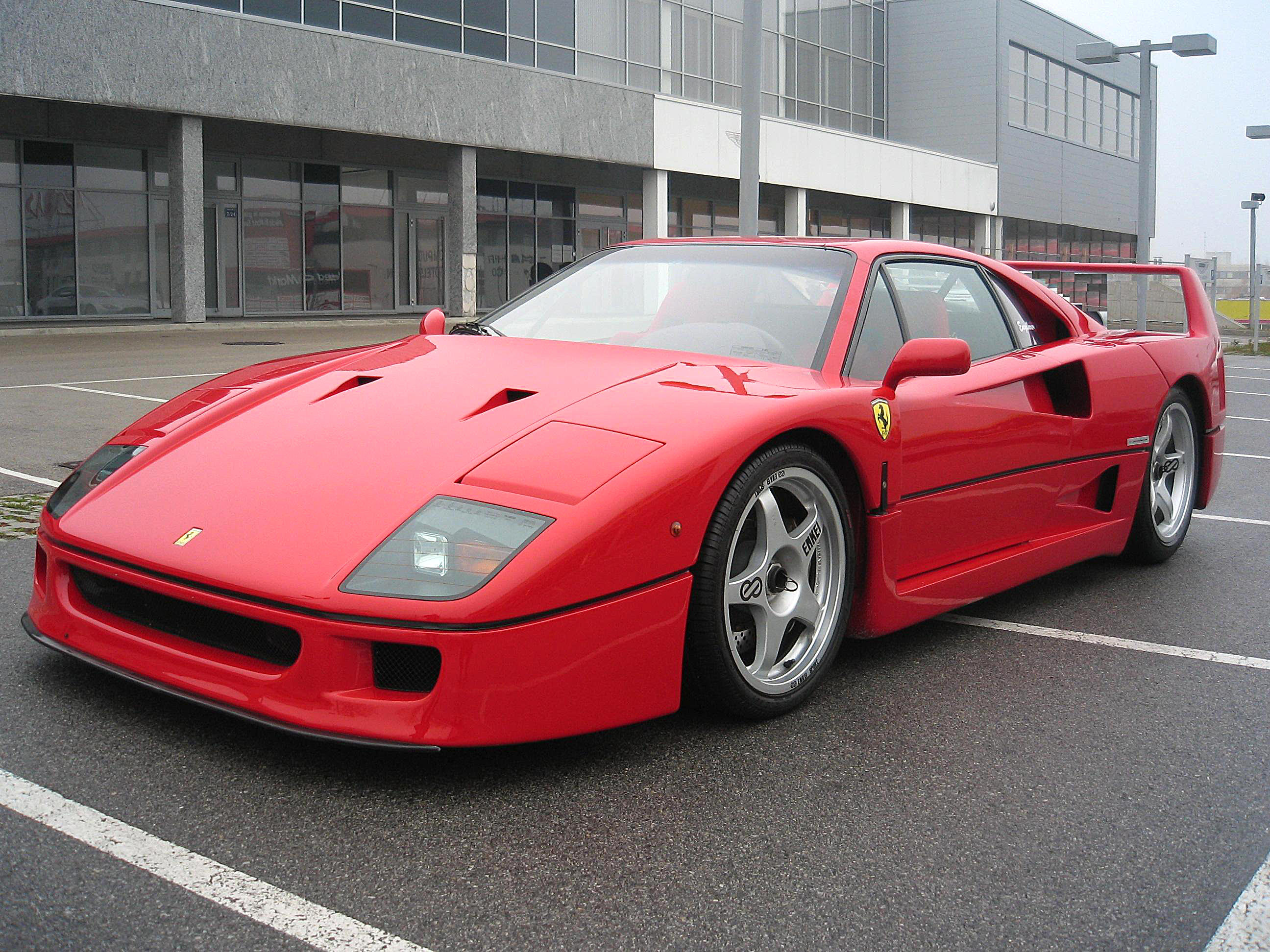1990 FERRARI F40 COACHWORK BY PININFARINA Chassis No. ZFFMN34A4L0086992 Ferrari Red with red and black interior Engine: 90 degree V8, two belt-driven overhead camshafts per bank operating 4 valves per cylinder, with electronic port fuel injection and two IHI RHB 53 LW turbochargers and air-air intercoolers, 2,936cc, 478hp at 7,000rpm; Gearbox: five speed; Suspension: front and rear, independent by unequal wishbones with concentric coil springs and tubular shock absorbers; Brakes: four wheel discs. Left hand drive. After success with turbocharged engines in the short-lived 1 litre Formula One, in 1984 Ferrari introduced its first road-going twin turbo V8 in the 288GTO, a technical exercise that never produced its intended on-track success due to changes in FIA sporting regulations that killed the Group B class Killer Bees for which it was intended. Nevertheless, the 288 GTO was a success, generating a great deal of publicity for Ferrari and demonstrating the packaging advantages of the mid-engine twin turbo V8 powertrain. Shortly thereafter, for the Fortieth Anniversary of Ferrari, Commendatore Ferrari charged his technical staff with the formidable task of developing a suitable automobile to commemorate not only that anniversary but also the prodigious accomplishments of Ferrari during those memorable two-score years. Seeking to recall one of Ferrari's most successful racing cars, the 250LM, Ferrari dug deeply into its high-tech bag of tricks to create the ultimate road-drivable supercar. F40 was the result, and what a convincing demonstration it was. It adopted the 288GTO Longitudinal mid-mounted twin turbo-charged V8 configuration, growing slightly in size from 2855cc and in power, from 400bhp and 366lb-ft torque to 478bhp and 426lb-ft torque. Using a conventional, for Ferrari, tube space frame, the F40 incorporated advanced composite materials in every possible application including its exterior panels. Pininfarina developed the body design in its inhouse wind tunnel, seeking the racer's compromise among aerodynamic drive, frontal area, high speed stability and downforce, finally producing drag coefficient (Cd) of 0.34, remarkable considering F40's huge tires and full-width rear wing. In keeping with F40's theme of translating racing car technology to the road, its interior is sparsely trimmed, the windows are sliding plexiglass panels and there are no power assists on either steering or the immense 13in diameter Brembo brakes. The only sound system available is the Ferrari symphony of valves, exhaust and turbos. Power assists are reserved for the things that affect performance, particularly the suspension which automatically drops 20mm (3/4in) at speed to improve the effectiveness of the car's aerodynamics and reduce undercar drag, and can be raised 20mm to clear driveways. F40's one concession to comfort is a minimal air conditioning system; just effective enough to keep the driver and passenger from baking on sunny Italian days. Best of all, for American enthusiasts, Ferrari went through the labyrinthine rituals of US DOT and EPA certification so the F40 could be sold to, and used by, Ferrari's many American customers. A year after its announcement the F40 was released to the public, to immediate acclaim in the motoring media and a huge demand for the artificially limited production of 400 cars. Ads appeared in car magazines and in the Wall Street Journal , offering to sell a confirmed order position for this anticipated collectible for 5-figure, and then 6-figure, amounts...which only got you the right to pay for the car. Eventually F40s traded for over $1 million. Despite the frenzy around F40's introduction, its performance, concept and execution has been confirmed in intervening years. Today it is recognized as a superb embodiment of il Commendatore's guiding principles, exactly as he intended, and the last great car designed, developed and built under his direct supervision in the spirit of the 250GTO and 250LM
1990 FERRARI F40 COACHWORK BY PININFARINA Chassis No. ZFFMN34A4L0086992 Ferrari Red with red and black interior Engine: 90 degree V8, two belt-driven overhead camshafts per bank operating 4 valves per cylinder, with electronic port fuel injection and two IHI RHB 53 LW turbochargers and air-air intercoolers, 2,936cc, 478hp at 7,000rpm; Gearbox: five speed; Suspension: front and rear, independent by unequal wishbones with concentric coil springs and tubular shock absorbers; Brakes: four wheel discs. Left hand drive. After success with turbocharged engines in the short-lived 1 litre Formula One, in 1984 Ferrari introduced its first road-going twin turbo V8 in the 288GTO, a technical exercise that never produced its intended on-track success due to changes in FIA sporting regulations that killed the Group B class Killer Bees for which it was intended. Nevertheless, the 288 GTO was a success, generating a great deal of publicity for Ferrari and demonstrating the packaging advantages of the mid-engine twin turbo V8 powertrain. Shortly thereafter, for the Fortieth Anniversary of Ferrari, Commendatore Ferrari charged his technical staff with the formidable task of developing a suitable automobile to commemorate not only that anniversary but also the prodigious accomplishments of Ferrari during those memorable two-score years. Seeking to recall one of Ferrari's most successful racing cars, the 250LM, Ferrari dug deeply into its high-tech bag of tricks to create the ultimate road-drivable supercar. F40 was the result, and what a convincing demonstration it was. It adopted the 288GTO Longitudinal mid-mounted twin turbo-charged V8 configuration, growing slightly in size from 2855cc and in power, from 400bhp and 366lb-ft torque to 478bhp and 426lb-ft torque. Using a conventional, for Ferrari, tube space frame, the F40 incorporated advanced composite materials in every possible application including its exterior panels. Pininfarina developed the body design in its inhouse wind tunnel, seeking the racer's compromise among aerodynamic drive, frontal area, high speed stability and downforce, finally producing drag coefficient (Cd) of 0.34, remarkable considering F40's huge tires and full-width rear wing. In keeping with F40's theme of translating racing car technology to the road, its interior is sparsely trimmed, the windows are sliding plexiglass panels and there are no power assists on either steering or the immense 13in diameter Brembo brakes. The only sound system available is the Ferrari symphony of valves, exhaust and turbos. Power assists are reserved for the things that affect performance, particularly the suspension which automatically drops 20mm (3/4in) at speed to improve the effectiveness of the car's aerodynamics and reduce undercar drag, and can be raised 20mm to clear driveways. F40's one concession to comfort is a minimal air conditioning system; just effective enough to keep the driver and passenger from baking on sunny Italian days. Best of all, for American enthusiasts, Ferrari went through the labyrinthine rituals of US DOT and EPA certification so the F40 could be sold to, and used by, Ferrari's many American customers. A year after its announcement the F40 was released to the public, to immediate acclaim in the motoring media and a huge demand for the artificially limited production of 400 cars. Ads appeared in car magazines and in the Wall Street Journal , offering to sell a confirmed order position for this anticipated collectible for 5-figure, and then 6-figure, amounts...which only got you the right to pay for the car. Eventually F40s traded for over $1 million. Despite the frenzy around F40's introduction, its performance, concept and execution has been confirmed in intervening years. Today it is recognized as a superb embodiment of il Commendatore's guiding principles, exactly as he intended, and the last great car designed, developed and built under his direct supervision in the spirit of the 250GTO and 250LM















Try LotSearch and its premium features for 7 days - without any costs!
Be notified automatically about new items in upcoming auctions.
Create an alert